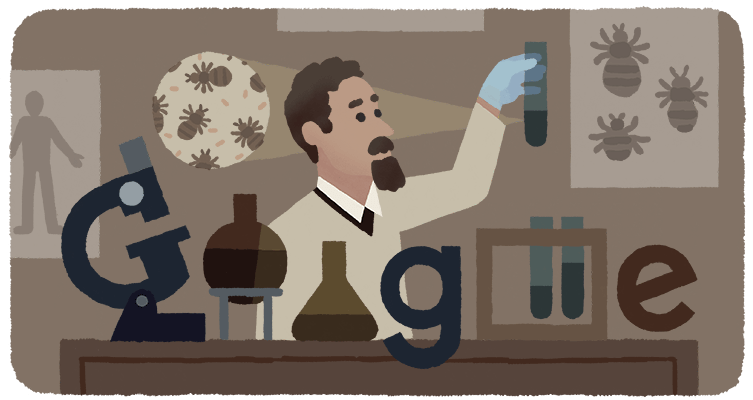Google Doodle honors Rudolf Weigl, the vaccine inventor who saved Jews from Nazis
Google Doodle honors Rudolf Weigl, the vaccine inventor who saved Jews from Nazis
Rudolf Stefan Jan Weigl (2 September 1883 – 11 August 1957) was a Polish biologist, physician, and inventor. He is most known for creating the first effective vaccine against epidemic typhus. He founded the Weigl Institute in Lwów (now Lviv), where he conducted vaccine research.
Weigl worked during the Holocaust to save the lives of many Jewish men and women. He played an active role during the time in which he developed a vaccine for typhus as well as provided shelter for Jews, in order to protect them from execution by the Nazis.
Vaccine development
In 1930, following Charles Nicolle’s 1909 discovery that lice were the vector of epidemic typhus, and following the work done on a vaccine for the closely related Rocky Mountain spotted fever, Weigl took the next step and developed a technique to produce a typhus vaccine by growing infected lice and crushing them into a vaccine paste. He discovered that a vaccine could be developed from lice stomachs infected with Rickettsia prowazeki, a harmful bacteria especially to humans.
https //signin.samsung.com/key/ : Login and Add my Samsung Account to Multiple Devices
He developed this first version of the vaccine in 1918 and began experimenting on guinea pigs and even human volunteers. He refined this technique over the years until 1933, when he performed large-scale testing in order to cultivate bacteria and experiment with the lice using a micro-infection strategy. The method comprised four major steps:
- Growing healthy lice, for about 12 days;
- Injecting them with typhus;
- Growing them more, for 5 additional days;
- Extracting the lice’s midguts and grinding them into a paste (which was the vaccine).
Growing lice meant feeding them blood, the more human the better. At first he tested his method on Guinea pigs, but around 1933 he began large-scale testing on humans, feeding the lice human blood by letting them suck human legs through a screen. This could cause typhus during the latter phase, when the lice were infected. He alleviated this problem by vaccinating the human “injectees”, which successfully protected them from death (though some did develop the disease). Weigl himself developed the disease, but recovered.
The first major application of his vaccine was conducted between 1936 and 1943 by Belgian missionaries in China. Soon, the vaccines were also administered in Africa. The vaccine was dangerous to produce and hard to make on a large scale. Over time, other vaccines were developed that were less dangerous and more economical to produce, including the Cox vaccine developed on egg yolk.
Google Celebrates Rudolf Weigl’s 138th Birthday with Doodle
Today’s Doodle celebrates the 138th birthday of Polish inventor, doctor, and immunologist Rudolf Weigl. He produced the first effective vaccine against epidemic typhus—one of humanity’s oldest and most infectious diseases.

On this day in 1883, Rudolf Stefan Weigl was born in the Austro-Hungarian town of Przerów (modern-day Czech Republic). He went on to study biological sciences at Poland’s Lwów University and was appointed as a parasitologist in the Polish Army in 1914. As millions across Eastern Europe were plagued by typhus, Weigl became determined to stop its spread.
Body lice were known to carry the typhus-infecting bacteria Rickettsia prowazekii, so Weigl adapted the tiny insect into a laboratory specimen. His innovative research revealed how to use lice to propagate the deadly bacteria which he studied for decades with the hope of developing a vaccine. In 1936, Weigl’s vaccine successfully inoculated its first beneficiary. When Germany occupied Poland during the outbreak of the Second World War, Weigl was forced to open a vaccine production plant. He used the facility to hire friends and colleagues at risk of persecution under the new regime.
An estimated 5,000 people were saved due to Weigl’s work during this period–both due to his direct efforts to protect his neighbors and to the thousands of vaccine doses distributed nationwide. Today, Weigl is widely lauded as a remarkable scientist and hero. His work has been honored by not one but two Nobel Prize nominations!
From studying a tiny louse to saving thousands of human lives, the impacts your tireless work had on the world are felt to this day—Happy Birthday, Rudolf Weigl!